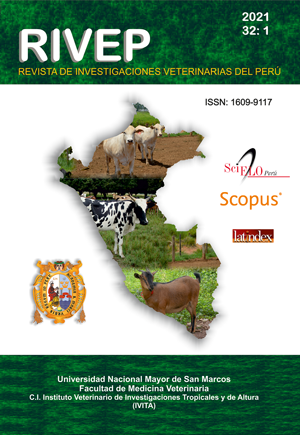Association between the presentation of endometritis and serum calcium levels in dairy intensive cattle (Lima, Peru)
DOI:
https://doi.org/10.15381/rivep.v32i1.17741Keywords:
calcium level, endometritis, subclinical hypocalcemia, dairy cows, postpartumAbstract
The aim of the research was to study the association between the presentation of endometritis and serum calcium levels in intensively reared dairy cows from Lima, Peru. The study was carried out with 76 Holstein cows. Blood samples were taken on the seventh day of parturition to measure calcium levels using a spectrophotometer, considering 8 mg/dl as the threshold to determine the presence of subclinical hypocalcemia. The diagnosis of endometritis was made at 35 ± 3 days postpartum using the commercial Metricheck® device to evaluate the appearance of vaginal fundus discharge, considering as endometritis a score greater than or equal to 2 on the McDougall scale. A significant difference was found between multiparous cows with and without hypocalcemia in the presentation of endometritis (p<0.02), showing 1.65 times more probability of presenting endometritis than animals with normocalcemia. It is concluded that there is an association between the presentation of endometritis in multiparous cows with subclinical hypocalcemia.
Downloads
Downloads
Published
Issue
Section
License
Copyright (c) 2021 Irma Arévalo R., Luis Ruiz, Néstor Chagray A., Rocio Silvia Sandoval Monzon

This work is licensed under a Creative Commons Attribution-NonCommercial-ShareAlike 4.0 International License.
AUTHORS RETAIN THEIR RIGHTS:
a. Authors retain their trade mark rights and patent, and also on any process or procedure described in the article.
b. Authors retain their right to share, copy, distribute, perform and publicly communicate their article (eg, to place their article in an institutional repository or publish it in a book), with an acknowledgment of its initial publication in the Revista de Investigaciones Veterinarias del Perú (RIVEP).
c. Authors retain theirs right to make a subsequent publication of their work, to use the article or any part thereof (eg a compilation of his papers, lecture notes, thesis, or a book), always indicating the source of publication (the originator of the work, journal, volume, number and date).










